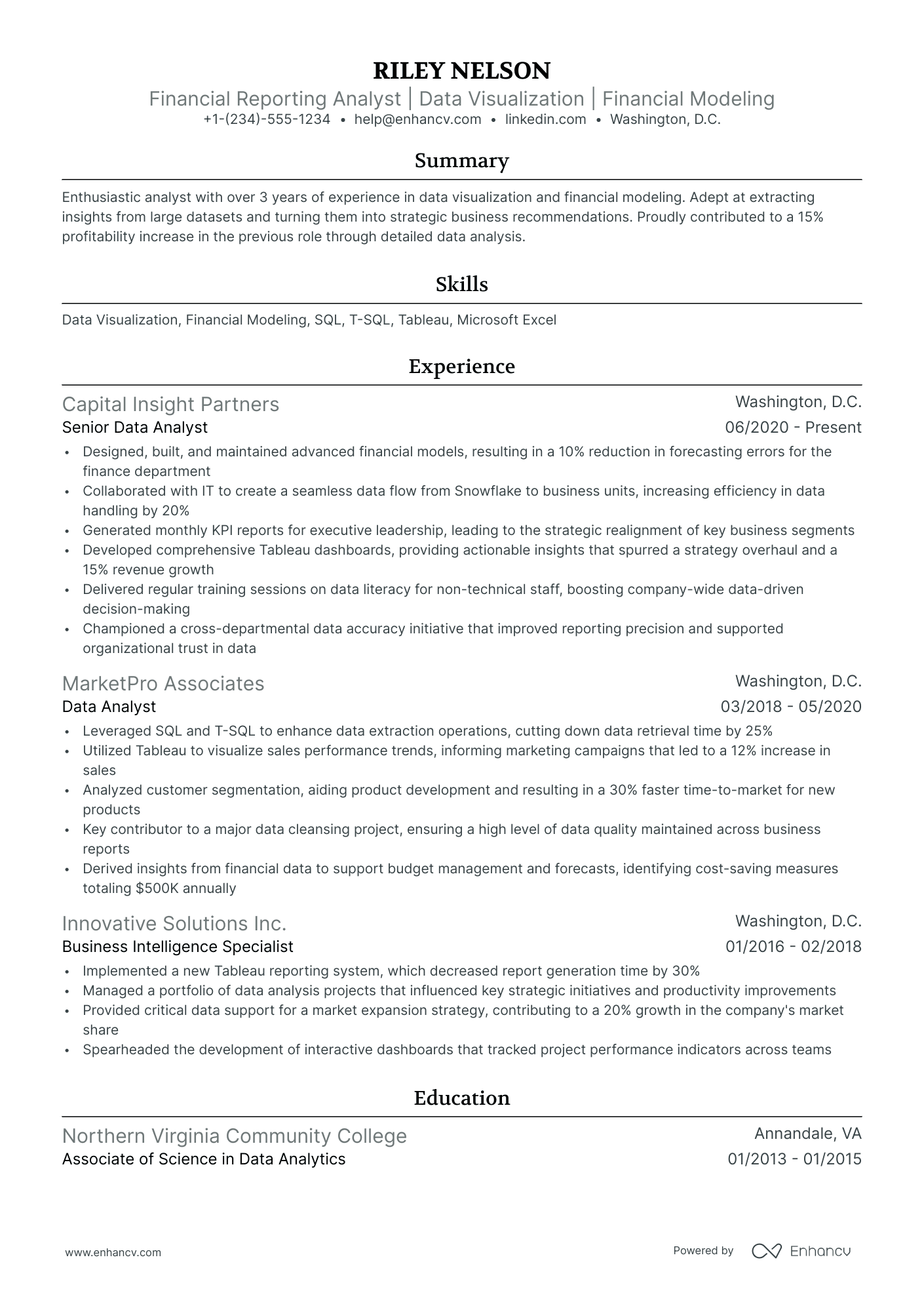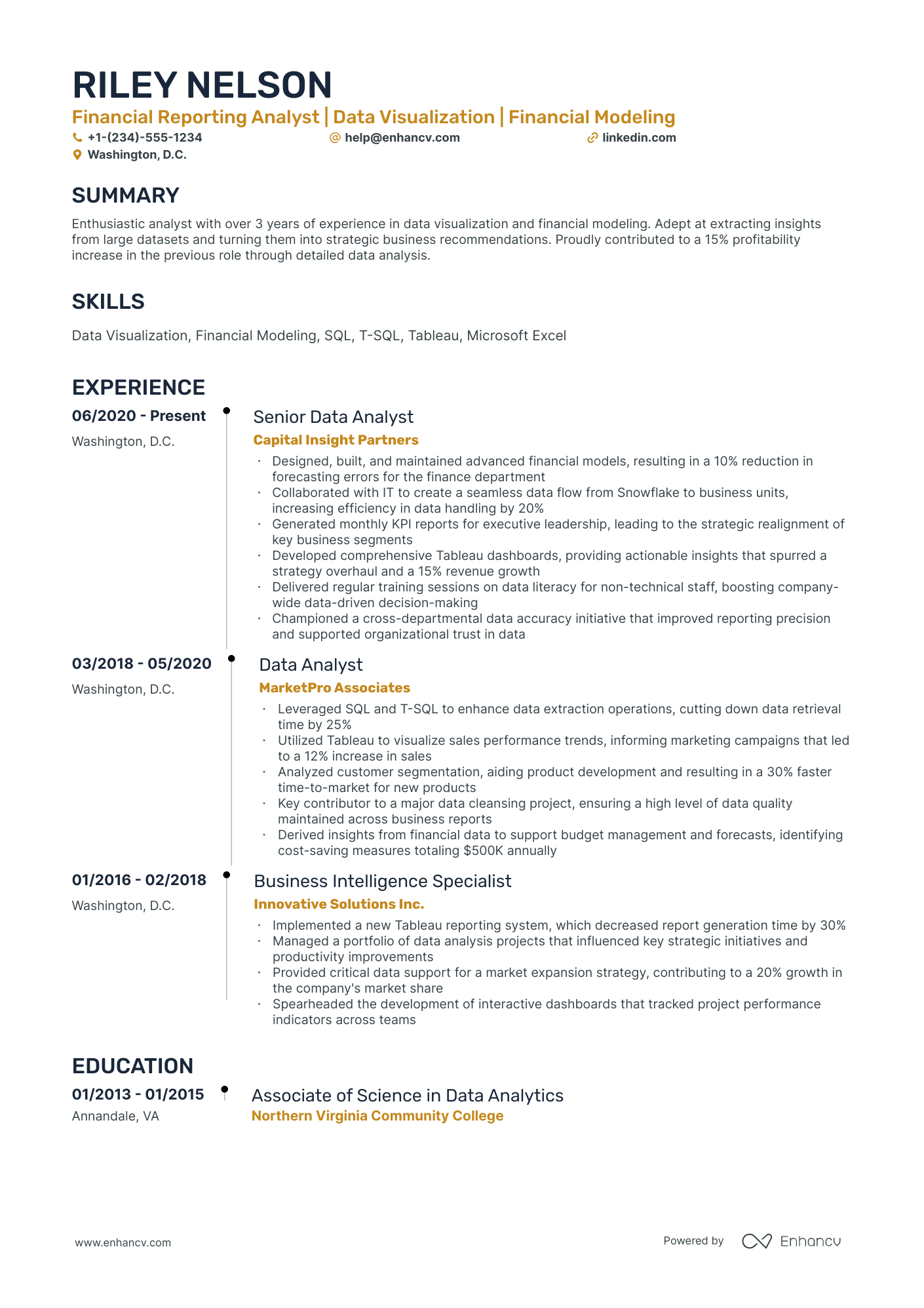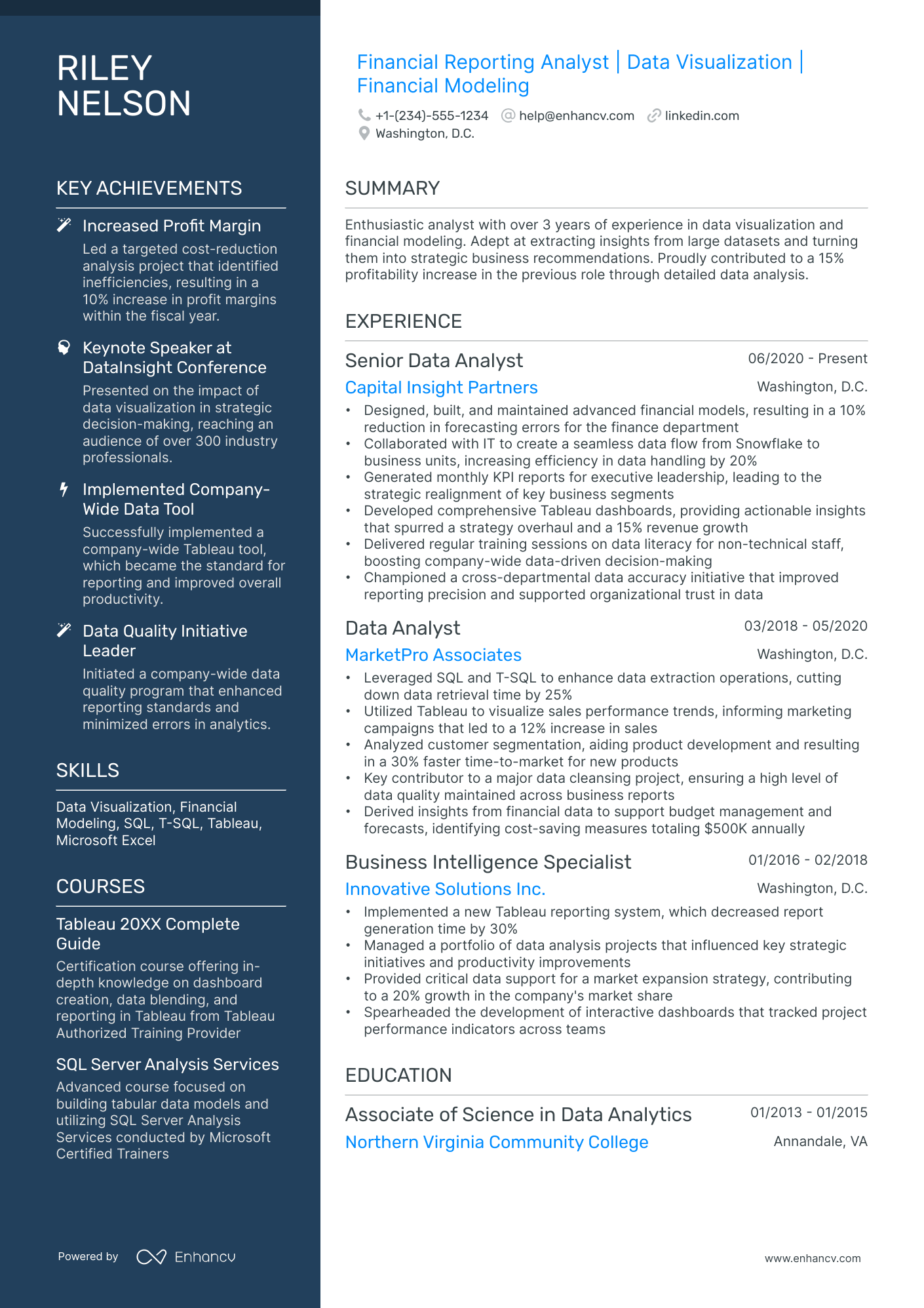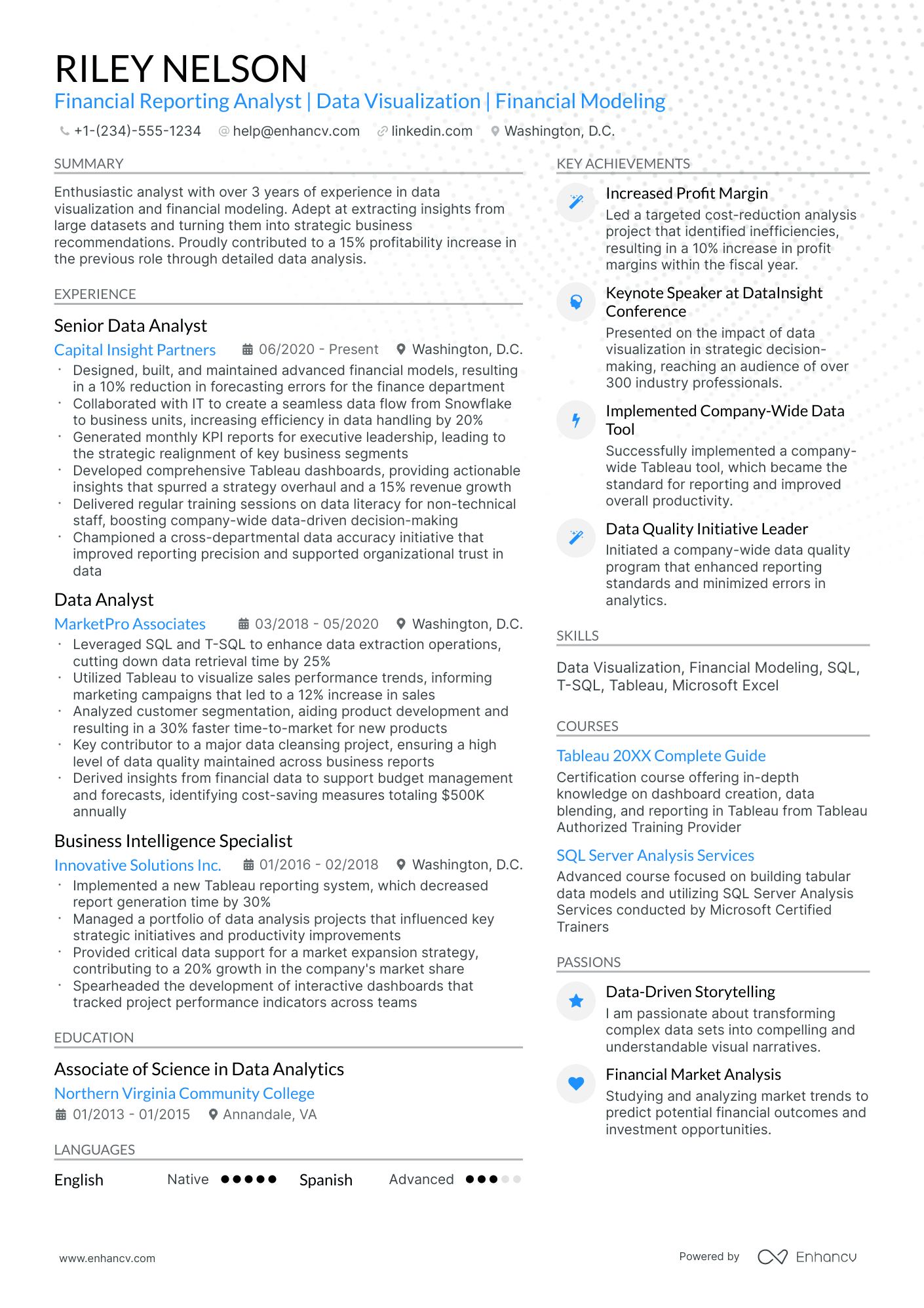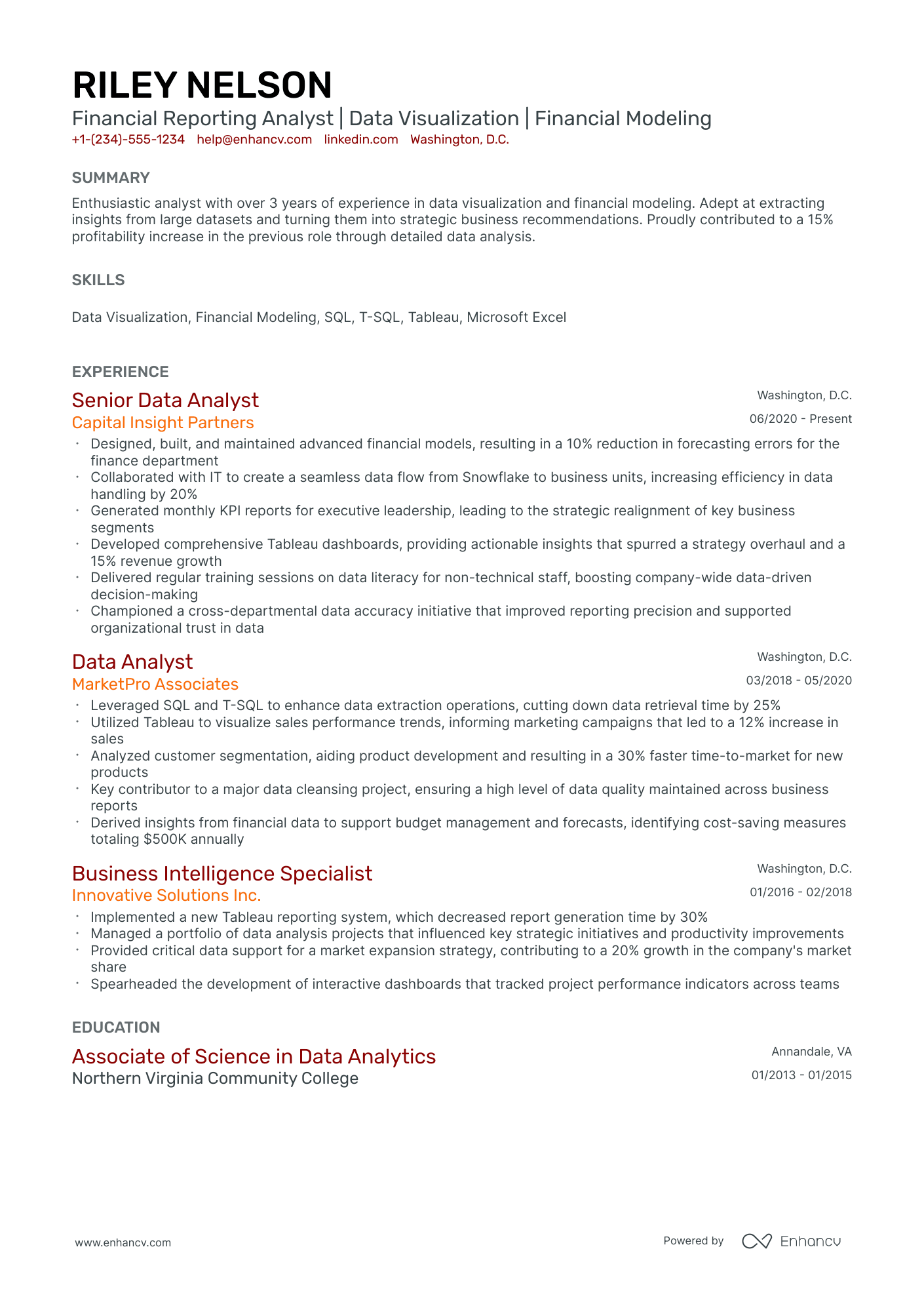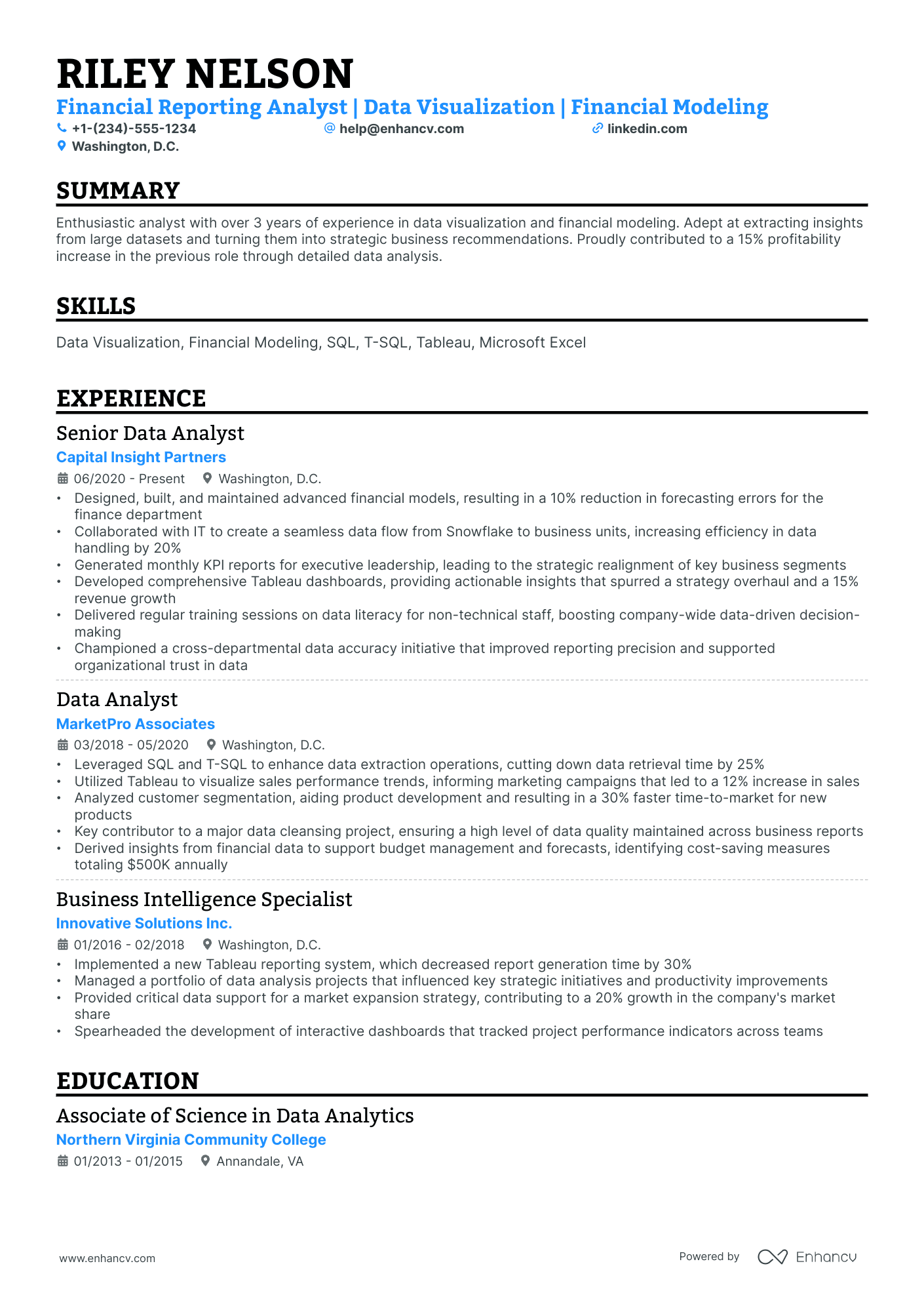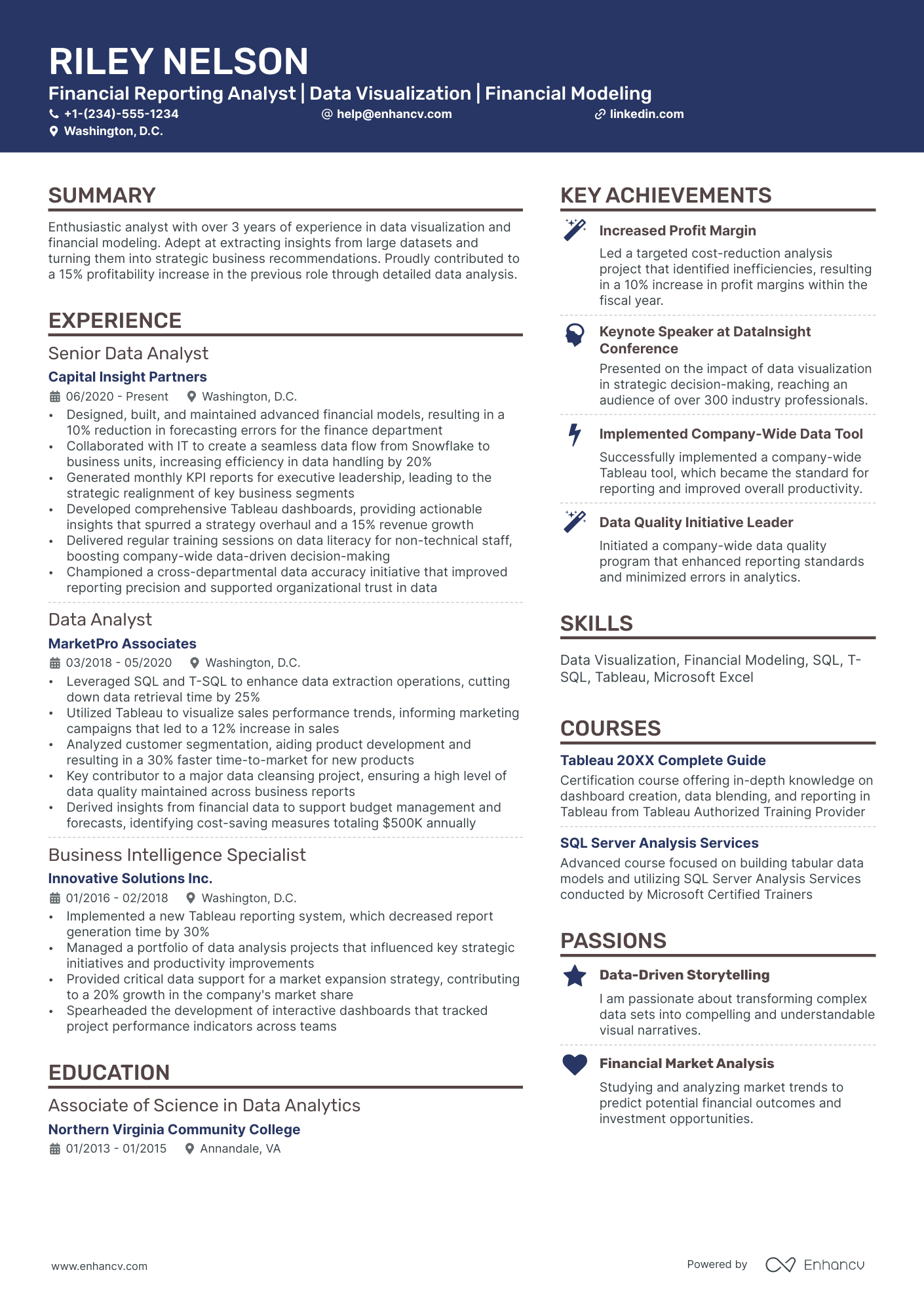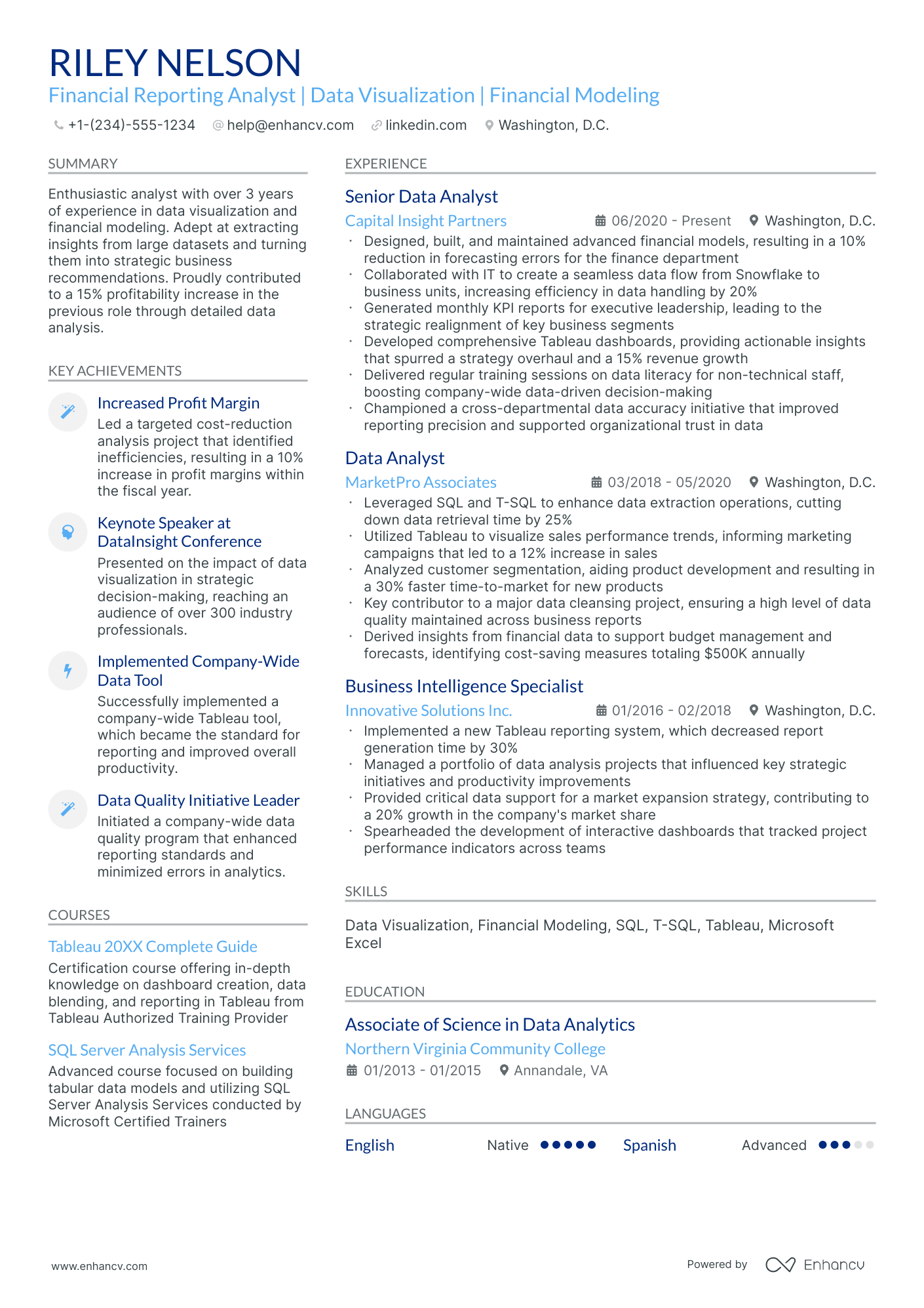As a financial reporting analyst, distilling complex financial data into concise bullet points that showcase your analytical prowess can be a daunting resume challenge. Our guide provides tailored strategies to help you effectively communicate your expertise, ensuring your resume highlights the impactful insights and strategic recommendations you're known for in your field.
- Sample industry-leading professional resumes for inspiration and financial reporting analyst resume-writing know-how.
- Focus recruiters' attention on what matters most - your unique experience, achievements, and skills.
- Write various resume sections to ensure you meet at least 95% of all job requirements.
- Balance your financial reporting analyst technical expertise with personality to stand out amongst candidates.
If the financial reporting analyst resume isn't the right one for you, take a look at other related guides we have:
- Management Accounting Resume Example
- Private Equity Resume Example
- Collector Resume Example
- Functional Accounting Resume Example
- Government Accounting Resume Example
- Forensic Accounting Resume Example
- Bank Branch Manager Resume Example
- Junior Financial Analyst Resume Example
- Senior Finance Manager Resume Example
- Financial Accounting Resume Example
Best practices for the look and feel of your financial reporting analyst resume
Before you even start writing your financial reporting analyst resume, first you need to consider its layout and format.
What's important to keep in mind is:
- The reverse-chronological resume is the most widely used format to present your experience, starting with your latest job.
- Your financial reporting analyst resume header needs to include your correct, professional contact details. If you happen to have a professional portfolio or an updated LinkedIn profile, include a link to it.
- Ensure your resume is no longer than two pages - you don't have to include irelevant experience on your resume just to make it look longer.
- Unless specified otherwise, submit your resume in the most popular format, the PDF one, as this will ensure your financial reporting analyst resume isn't altered.
Keep in mind market-specific formats – for example, a Canadian resume might follow a different structure.
Upload & Check Your Resume
Drop your resume here or choose a file. PDF & DOCX only. Max 2MB file size.
PRO TIP
If the certificate you've obtained is especially vital for the industry or company, include it as part of your name within the resume headline.
The five (plus) definite sections your resume for a financial reporting analyst job should include are:
- Header with your headline, contact details, and/or a preview of your work
- Summary (or objective) to pinpoint how your success aligns with the role
- Experience with bullets of your most relevant achievements in the field
- Skills to integrate vital job requirements (both technical and personal)
- Your further dedication to the field, showcased via relevant higher education and/or certifications
What recruiters want to see on your resume:
- Proficiency in financial reporting tools such as Hyperion, SAP, or Oracle Financials.
- Expertise in accounting principles, including GAAP or IFRS, and the ability to apply them accurately.
- Experience with financial analysis, variance analysis, and the preparation of monthly, quarterly, and annual reports.
- Strong proficiency with Excel and the ability to utilize advanced functions for complex financial modeling and data analysis.
- Demonstrated experience in improving reporting processes and implementing new reporting systems or software.
Creating your financial reporting analyst resume experience to catch recruiters' attention
Remember that for the financial reporting analyst role, hiring managers are looking to see how your expertise aligns with their requirements. Here's where your resume experience section can help out. Make sure you:
- Include mainly roles that are relevant to the financial reporting analyst job you're applying for;
- Don't go too far back in your experience - recruiters will only care what you did a decade ago if it's really important for the financial reporting analyst role;
- Each bullet you include should say what you did, followed by the skills you used and the actual end result of your efforts;
- Quantify each of your achievements with numbers and possibly the overall effect it had on the organization;
- Highlight transferrable skills - or personal skills you've attained thanks to past jobs - that could be applicable within your potential workplace. This would showcase your unique value as a professional.
Formatting the experience section of your resume doesn't have to be an over-the-top deep dive into your whole career. Follow the financial reporting analyst resume examples below to see how industry-leading professionals are presenting their experience:
- Led the coordinated effort to automate financial reporting processes, reducing time spent on report generation by 35% while also enhancing accuracy.
- Played a key role in the implementation of an ERP system that improved data integrity for financial analysis, consolidations, and external reporting requirements.
- Developed complex financial models that forecasted company revenue streams with a margin of error under 5%, directly impacting strategic planning initiatives.
- Streamlined month-end close procedures, ensuring financial statements were published by the 5th business day, a 2-day improvement from the previous cycle.
- Collaborated with internal audit teams to identify risk areas, leading to enhanced control measures and a 20% reduction in audit discrepancies.
- Produced quarterly and annual reports compliant with SEC and other regulatory standards, which won the 'Excellence in Reporting' award from the Industry Regulators Association.
- Managed the transition to IFRS reporting standards for a multinational corporation, ensuring seamless adoption across all regional offices.
- Worked closely with IT to enhance the business intelligence platform, leading to a 25% reduction in time taken to retrieve and analyze financial data.
- Provided comprehensive financial variance analysis that directly influenced executive decision-making and resource allocation.
- Successfully coordinated with cross-functional teams to deliver an integrated annual report, illustrating the company's financial health and business strategy.
- Introduced new KPIs to the financial reports that better aligned with corporate objectives and performance monitoring, receiving management endorsement.
- Conducted detailed financial statement analysis for potential mergers and acquisitions, contributing to a 10% growth in company portfolio.
- Prepared and analyzed financial statements, ensuring compliance with GAAP, which contributed to the company's reputation for financial transparency.
- Enhanced the quarterly earnings release process, which improved communication with investors and analysts and increased investor confidence.
- Coordinated with external auditors to provide necessary documentation and explanations for year-end audits, resulting in a 15% faster audit completion.
- Oversaw the preparation of financial statements for 10+ subsidiaries, ensuring timely and accurate reports that contributed to a holistic view of the company's financial performance.
- Initiated a project to digitize historical financial records, enhancing data retrieval speeds by 50% and significantly improving research capabilities.
- Acted as the primary point of contact during quarterly reviews and annual audits, which led to zero non-compliance findings over a 4-year period.
- Designed and implemented a new report distribution process utilizing a cloud-based platform, which increased accessibility for remote stakeholders by 100%.
- Developed an analytical tool to predict the financial impact of market changes on company performance with 90% accuracy, aiding in proactive strategy adjustments.
- Presented detailed financial analysis and insights at monthly executive meetings, driving a data-informed approach to decision making.
- Contributed to a cross-departmental project to streamline regulatory reporting, reducing the time to compile reports by 40% without sacrificing detail or accuracy.
- Enhanced financial forecast accuracy through the introduction of a new statistical modeling technique, which became the standard across the finance department.
- Authored a monthly financial report commentary that distilled complex financial terminology into business language, improving understanding among non-financial managers.
- Assisted in redesigning the annual budget process, resulting in a streamlined workflow that saved the company over 200 man-hours annually.
- Conducted a comprehensive benchmarking study to evaluate the company's financial reporting processes against industry peers, identifying opportunities for improvement.
- Managed the integration of newly acquired companies into the corporate financial reporting structure, ensuring seamless inclusion in consolidated financial statements.
- Automated key reporting elements within the financial reporting package, reducing chances of human error and delivering reports 3 business days earlier than the industry average.
- Created a suite of financial dashboards that provided real-time financial metrics, enabling executives to make timely and informed business decisions.
The following content includes information from "O*NET OnLine" by the U.S. Department of Labor, Employment and Training Administration (USDOL/ETA). Used under the CC BY 4.0 license. The data represents the top responsibilities present on the task lists for financial reporting analyst professionals.
Top Responsibilities for Financial Reporting Analyst:
- Advise clients on aspects of capitalization, such as amounts, sources, or timing.
- Analyze financial or operational performance of companies facing financial difficulties to identify or recommend remedies.
- Assess companies as investments for clients by examining company facilities.
- Collaborate on projects with other professionals, such as lawyers, accountants, or public relations experts.
- Collaborate with investment bankers to attract new corporate clients.
- Conduct financial analyses related to investments in green construction or green retrofitting projects.
- Confer with clients to restructure debt, refinance debt, or raise new debt.
- Create client presentations of plan details.
- Determine the prices at which securities should be syndicated and offered to the public.
- Develop and maintain client relationships.
Quantifying impact on your resume
- Detail the size of the financial portfolios you managed to demonstrate the scale of your responsibilities.
- Include the number of financial reports you've produced to showcase your productivity and experience.
- Specify the percentage of budget reductions you achieved through cost-saving initiatives to show your ability to drive profitability.
- Mention the amount of revenue or profit growth realized from your strategic financial analysis to highlight your contribution to growth.
- Quantify the accuracy of your financial forecasts to emphasize your analytical precision.
- List the number of compliance audits successfully passed due to your stringent financial reporting to prove your attention to regulatory standards.
- State the amount of time saved by automating or streamlining financial processes to reflect efficiency improvements.
- Provide the number of cross-departmental projects you've worked on to illustrate your collaborative skills and versatility.
Action verbs for your financial reporting analyst resume
What if you don't have any experience?
There are two very common scenarios about candidates with less experience. They are either:
- Fresh out of college in search of a financial reporting analyst role
- Transferring over from a completely different field
Both of these types of candidates still have a shot at landing their first job in the industry.
All they need to do about the experience section of their financial reporting analyst resume is:
- Consider their strengths - would the outcomes of their previous roles or niche skill sets impress recruiters? Feature those towards the top of your resume
- Exclude any and all irrelevant experience items - remember that at the end of the day, you're telling a story that aims to align with the ideal candidate for the financial reporting analyst job
- Win recruiters over with personality - perhaps your ambition, dreams, and diligence would make you the perfect fit for the financial reporting analyst role. Dedicate resume space to detail your personality traits by showcasing how they've helped you succeed in past roles
- Tailor your experience to specific job requirements - ensure your financial reporting analyst resume answers the advert in the best way possible.
Recommended reads:
PRO TIP
If you happen to have some basic certificates, don't invest too much of your financial reporting analyst resume real estate in them. Instead, list them within the skills section or as part of your relevant experience. This way you'd ensure you meet all job requirements while dedicating your certificates to only the most in-demand certification across the industry.
Balancing hard and soft skills in your financial reporting analyst resume
Recruiters indeed pay close attention to the specific hard and soft skills candidates possess. Hard skills refer to technical abilities or your proficiency in technologies, while soft skills are the personal attributes and qualities developed over your lifetime.
If you're unsure about effectively quantifying these skills on your resume, follow our step-by-step guide. It's crucial to first understand the key job requirements for the role. Doing so enables you to accurately list your:
- Hard skills in sections like skills, education, and certifications. Your technical expertise is straightforward to quantify. Most organizations find it sufficient to mention the certificates you've earned, along with your proficiency level.
- Soft skills within your experience, achievements, strengths, etc. Defining interpersonal communication traits in your resume can be challenging. Focus on showcasing the accomplishments you've achieved through these skills.
Remember, when tailoring your financial reporting analyst resume, ensure that the skills you list match exactly with those in the job requirements. For instance, if the job listing specifies "Microsoft Word," include this exact term rather than just "Word" or "MSO."
Top skills for your financial reporting analyst resume:
Excel
SQL
Financial Modeling
GAAP
Financial Statement Analysis
SAP
Oracle Financial Services
Power BI
Tableau
Hyperion
Analytical Thinking
Attention to Detail
Problem Solving
Communication
Teamwork
Time Management
Adaptability
Critical Thinking
Organizational Skills
Interpersonal Skills
Next, you will find information on the top technologies for financial reporting analyst professonals from "O*NET OnLine" by the U.S. Department of Labor, Employment and Training Administration (USDOL/ETA). Used under the CC BY 4.0 license.
Top technologies for Financial Reporting Analyst’s resume:
- IBM SPSS Statistics
- The MathWorks MATLAB
- Google Docs
- Microsoft Word
- Oracle E-Business Suite Financials
- Oracle Hyperion Financial Management
PRO TIP
Mention specific courses or projects that are pertinent to the job you're applying for.
Including your education and certification on your financial reporting analyst resume
The significance of your resume education section is paramount. It can show your diverse talents and experiences that are relevnt to the position.
- Incorporate educational qualifications, mentioning the institution and period.
- If you're on your academic journey, pinpoint your expected completion date.
- Opt for leaving out degrees that don't serve the job's purpose.
- Provide an overview of your educational experiences if it spotlights your milestones.
When recruiting for financial reporting analyst roles, candidates with relevant education and certification definitely stand out amongst competitors.
Showcase your academic background in the best way possible by:
- Listing all degrees and certifications that are part of the candidate qualifications in the financial reporting analyst advert
- Including any extra certificates, if they make sense to your application
- Not going over the top in details - the certificate name, institution, and dates are enough
- If you're in the process of obtaining a degree or certificate that's relevant to the job, include your expected graduation/certification dates
The education and certification sections help back up your application with years of experience in the industry or niche.
Select some of the most cutting-edge or applicable credentials for your next financial reporting analyst application from our list:
The top 5 certifications for your financial reporting analyst resume:
- Certified Public Accountant (CPA) - American Institute of Certified Public Accountants (AICPA)
- Chartered Financial Analyst (CFA) - CFA Institute
- Certified Management Accountant (CMA) - Institute of Management Accountants (IMA)
- Chartered Global Management Accountant (CGMA) - Association of International Certified Professional Accountants
- Financial Risk Manager (FRM) - Global Association of Risk Professionals (GARP)
The content below includes information from "O*NET OnLine" by the U.S. Department of Labor, Employment and Training Administration (USDOL/ETA). Used under the CC BY 4.0 license. The data represents the top associations for financial reporting analyst professionals.
Top US associations for a Financial Reporting Analyst professional
- Association for Financial Professionals
- Alternative Investment Management Association
- American Bankers Association
- American Economic Association
- American Finance Association
PRO TIP
If the certificate you've obtained is especially vital for the industry or company, include it as part of your name within the resume headline.
Recommended reads:
Which one to use: a resume summary or a resume objective?
The financial reporting analyst resume summary or objective serves as a good introduction to your experience for recruiters.
Have you ever wondered which one (the summary or objective) will be more appropriate for your financial reporting analyst resume?
- If you are a less experienced professional, write a resume objective statement. The objective is about three sentences long and provides recruiters with information about your career goals, strengths, and achievements . It should basically denote how you see yourself in this particular role, and what is your relevant experience and/or know-how;
- If you happen to have plenty of relevant experience, select your most impressive achievements for your resume summary. The summary is no longer than five sentences and serves as a storytelling instrument - highlighting your greatest career wins . Don't forget to align your summary with the job requirements to ensure your resume stays relevant to the role.
Read on for more information and examples of resume summaries and objectives from real world professionals.
Resume summaries for a financial reporting analyst job
- With over 8 years as a dedicated financial reporting analyst at a Fortune 500 company, I've honed an expertise in GAAP, IFRS, and advanced Excel functions, delivering reports that have streamlined financial processes and driven company profitability.
- Results-oriented financial expert with a CPA certification and 10 years of experience in constructing robust financial models and developing comprehensive reports that have consistently guided critical business decisions at a top-tier investment bank.
- Former Senior Data Analyst with 5 years of experience transitioning to financial reporting, bringing a strong background in statistical analysis, Python, and SQL programming, coupled with a proven track record of transforming data into actionable insights.
- Career educator with a Master's in Economics making the leap to financial reporting analysis, equipped with strong quantitative skills, knowledge of economic forecasting, and a passion for translating financial trends into strategic business plans.
- As a recent finance graduate, I am eager to apply my academic knowledge of financial analysis and reporting, coupled with my internship experience at a regional bank, to a dynamic and growth-oriented organization.
- Energetic MBA with a concentration in Finance seeking to leverage internships in commercial banking and proficiency in SAP and Oracle to contribute fresh perspectives to a forward-thinking financial team, particularly in analyzing trends and crafting strategic financial decisions.
Optimize your resume summary and objective for ATS
Drop your resume here or choose a file.
PDF & DOCX only. Max 2MB file size.
Average salary info by state in the US for financial reporting analyst professionals
Local salary info for Financial Reporting Analyst.” Source: My Next Move, National Center for O*NET Development. Accessed 10/15/2024
| State | Average Salary (in USD) |
|---|---|
| US National Average | $99,010 |
| California (CA) | $109,080 |
| Texas (TX) | $87,950 |
| Florida (FL) | $81,680 |
| New York (NY) | $125,110 |
| Pennsylvania (PA) | $82,810 |
| Illinois (IL) | $101,510 |
| Ohio (OH) | $83,960 |
| Georgia (GA) | $83,610 |
| North Carolina (NC) | $99,990 |
| Michigan (MI) | $83,920 |
What else can you add to your financial reporting analyst resume
What most candidates don't realize is that their financial reporting analyst resumes should be tailored both for the job and their own skillset and personality.
To achieve this balance between professional and personal traits, you can add various other sections across your resume.
Your potential employers may be impressed by your:
- Awards - spotlight any industry-specific achievements and recognitions that have paved your path to success;
- Languages - dedicate some space on your financial reporting analyst resume to list your multilingual capabilities, alongside your proficiency level;
- Publications - with links and descriptions to both professional and academic ones, relevant to the role;
- Your prioritization framework - include a "My Time" pie chart, that shows how you spend your at-work and free time, would serve to further backup your organization skill set.
Key takeaways
- The logic of your resume presentation should follow your career highlights and alignment with the role;
- Curate information within different sections (e.g. summary, experience, etc.) that helps highlight your strengths;
- Exclude from your resume irrelevant experience items - that way you'd ensure it stays no longer than two pages and is easy to read;
- Dedicate space within the summary, experience, and/or achievements to highlight precisely why you're the best candidate for the role via your previous success;
- Both your technical and people capabilities should also play a crucial role in building up your financial reporting analyst application. Prove your skill set in various resume sections.
